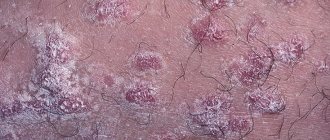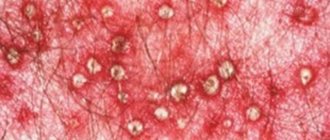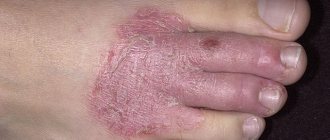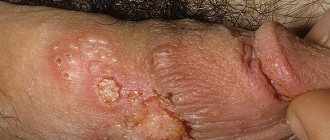Itching in the groin certainly affects the quality of life and interferes with the performance of daily functions. It is impossible to ignore it, therefore, when this symptom appears, the first question that arises is how to get rid of it. It should be noted that directly combating itching, without eliminating the cause that caused it, is pointless. Along with drugs with symptomatic effects, in this case soothing itching, drugs are prescribed aimed at suppressing the cause of the symptom.
If the itching is not caused by any disease, but is caused, for example, by a negative external influence, treatment may not be necessary. However, measures to eliminate it, including the use of certain medications, would be appropriate here as well. The reason for this phenomenon may be:
- allergic reaction (swelling, small rash, redness);
- irritation (the skin on the pubic area peels off and can be very itchy);
- failure to comply with hygiene rules;
- systemic diseases (diabetes, liver pathologies, etc.);
- general skin diseases;
- parasitic activity;
- fungal, bacterial infections (peeling between the legs, rashes, red spots in the groin, itching).
The most important thing is to correctly determine what exactly caused the itching in the groin area. All further measures will depend on this.
Why does groin itching occur?
There are many answers to the question why it itches in the groin, various rashes and redness appear. Starting from non-compliance with the rules of intimate hygiene and ending with sexually transmitted diseases.
Ignoring water procedures leads to blockage of the sebaceous glands, which provokes inflammatory processes accompanied by burning and itching. The sensations extend to the perineum.
The second etiological factor is urine, which is a strong irritant. After urination, a burning sensation and itching is felt. A similar picture is observed when wearing underwear made of synthetic fabrics.
More serious causes of itching in the groin in men include the following diseases:
- Scabies is a parasitic pathology caused by the scabies mite. The parasite penetrates deep into the dermis and lays eggs. The disease often occurs against the background of the development of allergic reactions;
- Candidiasis is a fungal disease. The etiology of development is due to low immune status and diabetes mellitus. In addition to itching, a whitish coating is detected on the head of the reproductive organ. The process of urination is painful;
- Dermatomycosis develops in damp conditions, the groin environment is the most favorable conditions for the activation and proliferation of pathogenic microorganisms. Caused by a fungal infection. Redness occurs on the dermis, small blisters with a watery base form;
- Herpes. The main reason is unprotected sexual contact with an infected partner. A distinctive feature from other diseases that cause itching is transparent blisters in the groin area and on the thighs;
- Chlamydia is an infectious disease that is sexually transmitted. The causative agent is chlamydia. In addition to itching, a man experiences pain when urinating, discharge appears from the head of the penis;
- Diabetes. The appearance of severe itching and burning may indicate a violation of the absorption of sugar in the blood, as a result of which the glucose in the body has critically increased. In addition, symptoms are observed: rash, increased specific gravity of urine per day, constant feeling of thirst.
For your information, dermatomycosis does not affect the reproductive organ and is localized exclusively in the groin area.
Itching is only a symptom indicating a pathological process in the body. It develops as a result of dysfunction of the kidneys and liver, due to endocrine disorders, hormonal imbalance and other diseases.
Harmless reasons
Oddly enough, many men go to the doctor with already advanced forms of the disease, when peeling is accompanied by many additional symptoms. For your attention, there are situations where there is no cause for concern:
- The problem appeared after the hair removal procedure. A common phenomenon, easily explained by sensitive skin in the groin area. Everything goes away within 1-3 days.
- after sexual intercourse. Here you need to be careful, as there is a risk of infection with fungal pathologies, lice pubis and scabies. In most cases, peeling appears after prolonged rubbing and is caused by irritation. It should go away within a day. May be slightly itchy as it heals.
- after purchasing new personal care products. If your skin starts to peel after using a new soap or shower gel, then the reason is obvious. The solution to the problem is eliminating the allergen. The affected area can and should be smeared with moisturizer. Do not treat with antiseptics under any circumstances, as they greatly dry the skin.
- new underwear. Unfortunately, buying new panties can also cause skin problems in the groin area. Especially if they are made of synthetic materials. Along with peeling, itching and redness may be present. To eliminate the problem, you will have to stop using synthetic materials altogether.
- prickly heat. A common phenomenon that occurs more among men engaged in heavy physical labor (loaders, miners, hot shop workers). High humidity provokes constant maceration of the skin and the appearance of small rashes in the groin, which may peel off during healing. There is only one solution to the problem - regular use of creams that dry out the skin and try to prevent the formation of moisture in the groin area.
Ingrown hairs can also cause small, flaky patches of skin to appear in the groin area. This problem can appear not only after hair removal. It is recommended to “break through” ingrown hairs in time and treat these areas with an antiseptic.
How to determine the causes of itching and redness in the groin?
Instructions for the use of Chloropyramine injections for psoriasis and analogues
If the groin is very itchy, or other alarming symptoms are observed that cause discomfort and unpleasant sensations, it is recommended to visit a doctor. First of all, you need to contact a urologist.
The doctor orders laboratory tests to determine the source of the problem. The patient may be redirected to another medical specialist if the disease is not within the competence of the urologist.
For example, if the etiology is due to a sexually transmitted infection, further studies are prescribed by a venereologist. If a scabies mite is suspected, they are sent to a dermatologist.
Main diagnostic aspects:
- Anamnesis collection. The doctor interviews the patient about the main complaints, lifestyle, and concomitant pathologies. It is clarified whether any family members have similar symptoms.
- Physical examination. An initial examination is carried out, allowing a preliminary assessment of the condition of the genital organs. The specialist determines the presence of redness, rash, blisters and other lesions in the groin.
It is worth knowing: it is impossible to see the causative agent of scabies in the groin area with the naked eye. The parasite is characterized by microscopic size.
To determine the presence of scabies mites, a dermatologist stains the skin with an iodine solution or another dye. Due to the effect of the dye, scabies appear on the skin. Visual diagnostics are also used, allowing the affected area to be magnified 600 times.
Parasites
Itching in men and women
A common reason why the pubic area may itch is due to parasitic organisms. These include pubic lice and scabies mites, which live in hair-covered areas. If there are parasites, red spots up to 10-15 mm in size each appear in the intimate area.
A clear sign of the presence of scabies mites on the skin is itching, which appears in the dark. It is at night that the female parasite creates passages in the epidermis and lays eggs in them, which causes the desire to scratch. Photos of red spots caused by tick bites can be seen below.
To get rid of parasites, you should shave the hair in the pubic area, wash with water and vinegar and use a special product. Pharmacies are full of ointments and sprays for lice and ticks.
Symptoms of genital scabies
Scabies is characterized by a symptom that cannot be ignored - unbearable itching, worse in the evening and at night. If you can control yourself during the day and manage not to scratch the affected area, then at night it is impossible to do this.
Additional signs of scabies in the groin (manifested in 50% of clinical pictures):
Instructions for use of Uniderm cream and ointment
- Severe skin irritation;
- Spread of redness in the groin area;
- Small rash near the reproductive organ.
When scratching, the skin is injured, small cracks and wounds are formed. A clear exudate is released from them, sometimes mixed with blood. When an additional infection occurs, pain develops and the rash becomes purulent.
Ignoring symptoms makes the situation worse. Numerous blisters with watery contents form on the genitals and groin. When they are damaged, an unpleasant odor is observed. Over time, the affected areas become crusted and spread throughout the entire groin.
Note: self-treatment rarely gives positive results. The therapy is complex, combining antiparasitic drugs and measures to prevent secondary infection.
STD
If a person is promiscuous and does not protect himself, he can become infected with a sexually transmitted infection. Such diseases include chlamydia, mycoplasmosis, candidiasis, and genital herpes.
Accompanied by the following symptoms:
Groin itching
- white plaque on the head of the penis in a man or unusual vaginal discharge in a woman;
- pink spots on the skin;
- itching;
- deterioration in general health;
- temperature increase;
- pain or burning during urination or sexual intercourse. Antibiotics and immune-boosting drugs are prescribed to treat most STDs.
How to get rid of itching in the groin?
To get rid of itching in the groin caused by scabies mites, topical medications are prescribed in the form of gels, creams, ointments, emulsions, and solutions. They help destroy not only the adult parasite, but also kill larvae and eggs.
Preparations for scabies:
- Sulfur ointment is an effective remedy with virtually no contraindications. The course of treatment lasts one week. The disadvantage is a specific smell. Sometimes adverse reactions with skin manifestations develop.
- Spregal is an antiparasitic agent in the form of a spray. Apply in the evening, convenient to use, does not leave marks on clothes, and has no odor. The course of treatment is determined individually.
- Permethrin is an effective drug that helps get rid of scabies in one application. Sometimes the procedure is repeated as a preventive measure. Treat the groin area before bed.
- Medifox is rubbed into the perineal area every day. The duration of the therapeutic course is one week. Apply immediately before bedtime.
If the patient consults a doctor at an advanced stage, then antihistamine tablets are recommended that reduce the severity of the allergic reaction - Suprastin, Tavegil.
Important: medications are prescribed by a doctor after receiving laboratory test results. The itching disappears a few hours after the first use.
Depilation
Itching in an intimate place
Many women and men remove pubic hair at home. After the hair removal procedure, irritation may occur and the pubic area may begin to itch. This is due to damage to the skin as a result of using a low-quality razor. To avoid redness and itching after shaving you need to:
- change razors often, ideally use a new one each time;
- steam the skin before shaving;
- Shave according to hair growth;
- use shaving gel.
Attention! The skin must be disinfected after epilation. You can use alcohol or hydrogen peroxide for this.
Prevention of itching in the groin area
To exclude secondary infection, drug therapy is combined with preventive measures:
- Compliance with personal hygiene rules;
- The patient’s bedding and underwear are washed at high temperatures or treated with specialized preparations. For example, A-Par spray;
- All household items are disinfected.
Itching, rash, redness in the groin area indicate various urological and parasitic diseases. The discomfort will not go away on its own. On the contrary, it will intensify every day. Only eradicating the root cause will improve your well-being.
Prevention measures
Many infectious diseases are much easier to prevent than to treat. There are several easy rules, the observance of which will allow you to avoid such problems, maintain health and a normal pace of life. These include:
- A carefully selected wardrobe, according to size and other individual characteristics.
- Limited use of synthetic clothing items, especially in hot weather.
- Strict adherence to hygiene rules when visiting public baths, swimming pools, showers.
- Refusal to use other people's personal hygiene items, clothing, and bedding.
- Regular water treatments with careful care of the groin area.
- Pickiness in sexual relations.
The male body is more resistant to pathogens of various diseases, but you should not test its strength and neglect the listed rules. If problems cannot be avoided, it is necessary to overcome false complexes and consult a doctor as soon as possible.
Folk remedies
In this case, various infusions and herbal decoctions are used, but their use is aimed at eliminating the symptoms, not the cause. General restoratives include fruit drinks made from cranberries, lingonberries, and rose hips.
A chamomile decoction is prepared, which has a calming and bactericidal effect. Sage, string, celandine, and calendula are also used. Dilute the baths, which take 20 minutes.
You can get rid of pubic lice using crushed cranberries, vinegar, and previously used kerosene (it was rubbed into the skin).
For dermatomycosis, be sure to change clothes daily, wipe the skin dry after bathing, and it is advisable to use powder (sweating is reduced).
What does eczema peeling look like?
Eczema develops as a result of exposure to various negative factors.
Among them are diseases of the hepatobiliary system, urinary tract, digestive organs, thyroid gland, as well as external factors (thermal or chemical).
Redness and severe peeling in the groin can occur with the contact form of the disease.
In this case, itching and inflammation are also present. In this case, the pathology may be caused by certain materials (latex).
When exposed to cosmetics and too frequent water procedures, papules containing pathological exudate may appear in the groin, skin dryness increases and irritation occurs.
The diagnosis is made based on the clinical picture and examination of the patient.
To eliminate eczema, antiallergic drugs are prescribed to reduce inflammation and itching.
The most commonly used are Claritin, Loratadine, Tavegil.
If necessary, medications are prescribed in injection form.
Glucocorticoids are also used - Prednisolone or Betamethasone, sedatives, vitamin complexes, sorbents.
For local treatment, use Trimistin or Sinaflan (antibacterial agents with corticoids).
Physiotherapeutic procedures are also used - ultraviolet irradiation, laser radiation, exposure to magnetic radiation).
Allergenic foods are excluded from the diet.










